Life is Like the Seasons
June 8, 2020Adapting After Lockdown.
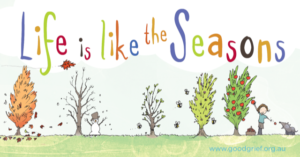 With schools resuming regular teaching across Australia after weeks of lockdown, some children will look forward to seeing their friends but for many others, returning to the classroom after an extended period will be challenging, especially for children and young people who are currently managing other life challenges that impact their capacity to adapt to change.
With schools resuming regular teaching across Australia after weeks of lockdown, some children will look forward to seeing their friends but for many others, returning to the classroom after an extended period will be challenging, especially for children and young people who are currently managing other life challenges that impact their capacity to adapt to change.
The urgent nature of the global response to COVID-19 has brought with it fast and unprecedented change to family, school and work life. The largely invisible but highly pervasive threat of the virus has been a testing time for everyone – with high levels of stress and anxiety further amplified by the realities of restrictions and uncertainty about whether and when life will be ‘normal’ again. Read more of this article from the Centre for Children and Young People. Download the resource.
Now, following weeks (months for some), without social interaction with friends, peers, extended family and other trusted adults – children and young people may be experiencing a range of emotions and behaviours. The array of change and unpredictability can leave us feeling overwhelmed and anxious. These feelings are normal and expected during times of transition and change. As professionals in education and support roles, we play a critical role in helping the transition of students back to school. There are familiar and core concepts in the literature about how to best support children and young people during difficult times. Please have a look at this new resource researched and written by CYRA and Seasons for Growth program author Prof Anne Graham AO, Director of the Centre for Children and Young People, SCU. LINK to new resource.
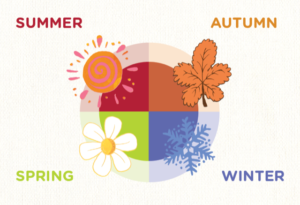 Children and young people rely on trusted adults to help manage transitions and so we have prepared an easy-to-read factsheet to support parents, carers and professionals – Self-Care & Wellbeing: During Times of Uncertainty.
Children and young people rely on trusted adults to help manage transitions and so we have prepared an easy-to-read factsheet to support parents, carers and professionals – Self-Care & Wellbeing: During Times of Uncertainty.
ONLINE LEARNING
To support professionals who are keen to train in the Seasons for Growth program, we have transitioned to a virtual training model and have received wonderful feedback! Professionals who have recently completed training have recognised the need for the program in our current climate and are already making plans to support the children and young people in their care as soon as they are able.
THANK YOU FOR SUPPORTING US
 We would also like to say thank you to all of you in the community and particularly the young people within the school communities who organised a fundraiser to donate funds to help those impacted by the bushfires. Your fundraiser will enable the ‘Stormbirds’ program to help bush-fire affected communities, like Glen Innes.
We would also like to say thank you to all of you in the community and particularly the young people within the school communities who organised a fundraiser to donate funds to help those impacted by the bushfires. Your fundraiser will enable the ‘Stormbirds’ program to help bush-fire affected communities, like Glen Innes.
Your donation gives children access to the program, books and helps to train a Companion.
Fiona McCallum and all the Good Grief Team
How you can help young Aboriginal Australians
Help young people overcome social and emotional challenges.
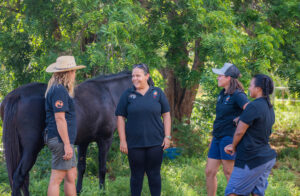 Disengagement from education is a significant concern amongst community members in the Kimberley region of Western Australia and local service providers are struggling to meet the needs of young Aboriginal people through programs that are culturally relevant and safe.
Disengagement from education is a significant concern amongst community members in the Kimberley region of Western Australia and local service providers are struggling to meet the needs of young Aboriginal people through programs that are culturally relevant and safe.
Thanks to the generosity of people like you, Mary MacKillop Today can continue to work alongside Aboriginal communities helping young people engage with education.
Will you help young people to overcome the social and emotional challenges that make it incredibly difficult to engage in learning?
Please give today to support the Equine Assisted Learning program in the Kimberley, named Yawardani Jan-ga which means “horses doing healing.”
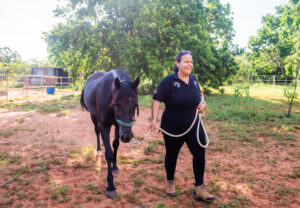 Delivered in partnership with the Telethon Kids Institute, the Yawardani Jan-ga program is owned and facilitated by experienced and qualified Aboriginal community members like Abby-Rose.
Delivered in partnership with the Telethon Kids Institute, the Yawardani Jan-ga program is owned and facilitated by experienced and qualified Aboriginal community members like Abby-Rose.
Josephite Charism
Never See a Need…. During a Pandemic.
Sisters, and those inspired by the charism of Mary MacKillop, have ministered in a Josephite spirit since 1866. They have been inspired by the words of their Founder Rev Julian Tenison Woods: ‘Never see a need without doing something about it’ and their ministries have been in many settings.
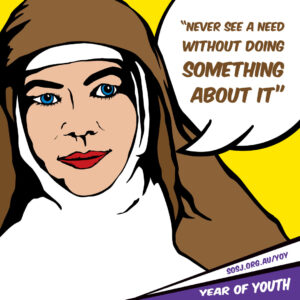 They have ministered with people in country, outback and city places in Australia, Aotearoa New Zealand, Ireland, Papua New Guinea, Timor Leste, Peru, Brazil and Fiji. They have worked in educational settings, in healthcare, in parishes and prisons. Those, women, children and families, who are poor have been the main focus and concern of the sisters. These include Indigenous persons, asylum-seekers and refugees. In order to minister, the sisters have often been found visiting homes, hospitals, “camps” in the Kimberleys, jails or detention centres. As they have aged or situations have changed, sisters over the years, have become involved in other ministries such as Spiritual Direction, being a Director of a Board or pastorally caring for the aged or mentally ill.
They have ministered with people in country, outback and city places in Australia, Aotearoa New Zealand, Ireland, Papua New Guinea, Timor Leste, Peru, Brazil and Fiji. They have worked in educational settings, in healthcare, in parishes and prisons. Those, women, children and families, who are poor have been the main focus and concern of the sisters. These include Indigenous persons, asylum-seekers and refugees. In order to minister, the sisters have often been found visiting homes, hospitals, “camps” in the Kimberleys, jails or detention centres. As they have aged or situations have changed, sisters over the years, have become involved in other ministries such as Spiritual Direction, being a Director of a Board or pastorally caring for the aged or mentally ill.
They were ready therefore to respond to the changes in mid-March 2020, when the Coronavirus was declared a Pandemic and people were told to “stay at home”. Indeed, the need now was to keep oneself safe so as not to be a burden on medical staff, hospitals, religious communities or society and not to spread the virus. Many found themselves praying, gardening, cooking, reading or following a creative pursuit. At first, meetings and appointments were crossed out of diaries. Then new meetings on ZOOM or telephone, started to be pencilled in. New ways were found to communicate, meditate communally, attend Liturgies, do courses and support others.
Some sisters worked from home in Leadership, as School Pastoral Workers, Spiritual Directors, Supervisors, and attending or giving Inservices. Contact was made with parents who were home-schooling children, asylum-seekers, or those finding it difficult socially or financially. Many candles were lit, and contemplative prayer and Novenas were offered, especially for those in countries where the virus was claiming many lives and causing enormous pain. There was concern too, for our own Josephite Sisters and Associates in various places, including Peru and Ireland, and indeed, for people all over the world.
Mystic, Julian of Norwich, lived most of her life (1342-c.1415) with the terrifying ‘Black Death’ which raged for most of her life and killed 25 million people in Europe. In her homeland of England, it is estimated that one–third of the population died. Yet Julian trusted in and taught about God’s unfailing love and wrote “All will be well; every manner of things will be well.” Centuries later, Saint Mary MacKillop wrote: “We must often feel weary and tired and yet God brings us through all these things” (5 June 1874). Our sisters and ancestors experienced the Spanish Flu a hundred years ago.
Josephites, inspired by those who have gone before us, continue to minister in new and unexpected ways, wherever each of us finds ourselves in this age and time in history.
Denise Brosnan rsj
Julian Tenison Woods: A Life – Chapters 9th to 11th
June 7, 2020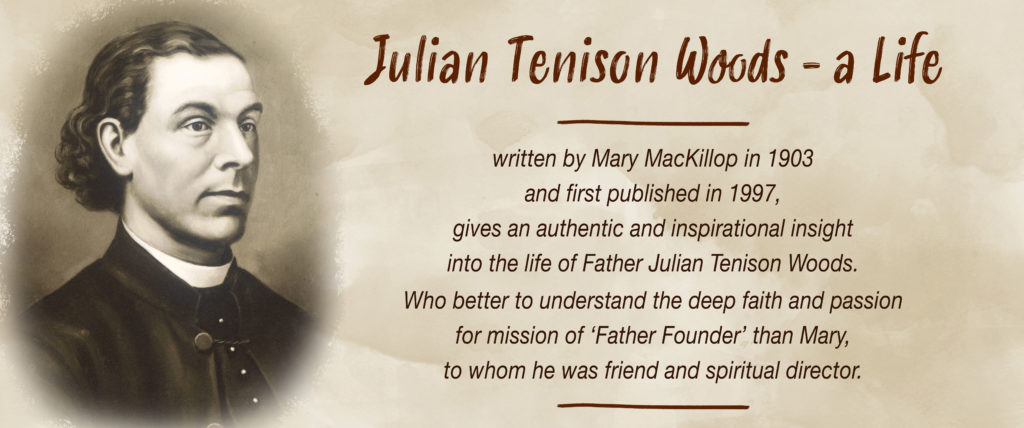
Chapters 9th, 10th and 11th
After the death of the Bishop [Murphy], the diocese was administered by the Vicar General, Father Ryan… [He] was well acquainted with the staunch old Catholics most of them Scotch – in the Penola district. [1]
Celebrating Communion and Oneness
Trinity Sunday 2020.
The God of “tenderness and compassion” (Exodus 34:6) is a God that we Christians have experienced as the Holy Trinity – three persons in one God. Through our initiation into the family of believers we are intimately related to the Father/Mother God through Jesus with whom God is one, and to the Spirit who proceeds from both, a love bond, a perfect communion.
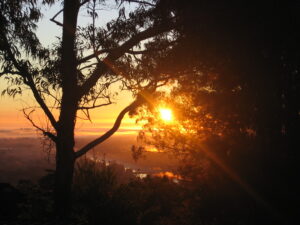
God, the ultimate ground of all that exists, is a community and where there is a community there is communion or oneness. Everywhere we look in our world, among humans and among the other-than-human creatures, we find communion, a communion that leads to a oneness. Eating food is a communion event that brings about oneness between the one eating and the food being consumed. Remembering is a communion event that can bring about a oneness between the present reality and the past. Worshipping God is a communion event that can deepen the oneness that exists between God, us and all creation.
Our scientists refer to the Universe as a single energy event, as a cosmic communion in which everything in the Universe is present to everything else in the Universe. We humans are “made in the image of God”, yet all of creation images God and carries the divine presence and purpose. Every being in our Universe has its own voice that speaks of the Ultimate Mystery out of which it came and within which it exists.
No matter where we look – up into the universe, out into this world or inside our own hearts, we can sense the presence of the three in one God. In every dimension of our existence God reveals Godself to us, sharing with us God’s life and drawing us into God’s love communion.
To exist is to exist in communion and in oneness. In honouring the Trinity, we are called to value, nurture and celebrate this communion and oneness. In this way we grow in wonder and in our love relationship with our tender and compassionate God (the Creator, Saviour and Sustainer), and we come to experience a cosmic communion.
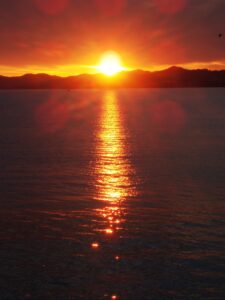
I don’t think we will be questioned at the pearly gates about what we know about the Mystery of the Trinity! What is important is that through the ups and downs of our daily life, we open ourselves to encounter the God who loves, the God who saves, the God who inspires, the God who invites us and all creation into a living, benevolent relationship.
In the words of Saint Paul’s Trinitarian Blessing: “May the grace of Jesus Christ, the love of God and the fellowship of the Holy Spirit be with [us] all” (2 Corinthians 13:13).
Therese McGarry rsj
World Environment Day, 5 June 2020
June 5, 2020World Environment Day 2020, Celebrating Biodiversity.
 The clarity of air which has appeared in some of the world’s big cities is a small silver lining to the COVID-19 horrors. It might bring home, more brilliantly than the most forceful arguments, the inextricable connection between we human beings and our environment. This is positive good news to the daily bad news evidence of dry rivers, super tornado’s, massive floods and extraordinary temperature rises of our wounded Earth.
The clarity of air which has appeared in some of the world’s big cities is a small silver lining to the COVID-19 horrors. It might bring home, more brilliantly than the most forceful arguments, the inextricable connection between we human beings and our environment. This is positive good news to the daily bad news evidence of dry rivers, super tornado’s, massive floods and extraordinary temperature rises of our wounded Earth.
We can see how willing, how yearning, Earth is, if we do our part, or as in this present time are forced to do our part. Arabunna Elder, Kevin Buzzacott, has long encouraged us, in his decades’ long worrying for country, for the wellbeing of his beloved Lake Eyre and Mound Springs country. It’s not a matter of we humans having to do it all on our own, he stated,
This year Australia’s environment laws are due for their, once in a decade, review. The Environmental Protection and Biodiversity Conservation (EPBC) Act is Australia’s central piece of national environmental law. It often happens when one reads the policy document of organisations, parts at least can sound impressive. Some Australian Environmental Non-Government Organisations (ENGO) such as the Australian Conservation Foundation, Friends of Earth and Greenpeace in their combined ENGO submission concerning nuclear issues, in relation to this review of the EPBC, insist the revamped Act should focus on outcomes.
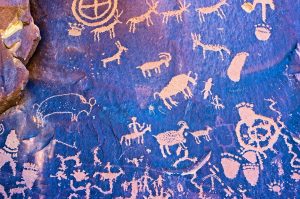 One example of this, could be, not only to name as valuable, First Nations’ knowledges and practices, as the EPBC Act certainly does, but to state how these practices could be enacted. This could involve upholding Aboriginal Heritage legislated rights, currently so easily dispensed in favour of mining and related industries. Current examples like the struggle of the Barngarla people of SA’s Eyre Peninsula against the proposed Federal nuclear dumps on their native title land, abound across the nation. Aspirations as in the EPBC Act in this vital area might be a start; aspirations plus action exponentially better!
One example of this, could be, not only to name as valuable, First Nations’ knowledges and practices, as the EPBC Act certainly does, but to state how these practices could be enacted. This could involve upholding Aboriginal Heritage legislated rights, currently so easily dispensed in favour of mining and related industries. Current examples like the struggle of the Barngarla people of SA’s Eyre Peninsula against the proposed Federal nuclear dumps on their native title land, abound across the nation. Aspirations as in the EPBC Act in this vital area might be a start; aspirations plus action exponentially better!
COVID-19, of course, has reminded us, more than any other evidence human beings may have chosen to ignore, how inextricably each country of our World is connected to the other. Australia for example, has one of the highest, per capita, pollution rates. Our own Josephite environment policy statement Towards Josephite Earth Sustainability calls us, in the words of Pope Francis, in Laudato Si, to ‘the moral imperative of assessing our every action and personal decision on the world around us.’ (#208). We know all this on one level and our Josephite heritage is such that the Congregational Eco-Spirituality Team’s submission to Chapter 2019 called us to return to the ‘light’ footprint of our early Josephites, a contemporary description of Mary MacKillop‘s many exhortations to her Sisters.
Many readers of this website will no doubt have their own renewable energy success stories. An encouraging one was found in the March report from the SA office of Congregation’s Centre West region. It described a project for their 100kw system; where 400 solar panels, were strategically placed on the Kensington Convent, which was the first Mother House of the Order. This produced environmental savings over 7 months, of 42.4 tons of Carbon Dioxide as well as considerable financial saving.
This is just one small step perhaps as all of us move along for Earth’s sake. The rewards are immediate – the alternatives unthinkable.
Michele Madigan rsj
Photo: Climate Man People Street by Markus Spiske from Pexels. Used with permission.
Image: Newspaper rock art by Mike Goad from Pixabay. Used with permission.
Mabo Day 2020
June 3, 2020We commemorate Mabo Day on 3 June to honour the courageous efforts of Eddie Koiki Mabo to overturn the fiction of terra nullius (land belonging to no-one).
Quote from a manifesto prepared for the Mabo Court Case

As we honour the life and work of Mr Edward Mabo, let’s consider the prosperity of many of us, and the dispossession, poverty, homelessness, hunger and early deaths of many Aboriginal and Torres Strait Islander (First Nations) people across Australia. First Nations People held the sovereign rights and cared for our country for thousands of years before colonisation. In the name of the British government Captain James Cook took the east coast of Australia in 1770, and for the next hundred years the entire country became crown land and was either leased, sold or granted to colonists.
As I wrote this reflection, I became aware of an open wound in Australia, and across the world, and all of us, as one body, holding the wounded one. Together birthing a love, we have longed for, but have never expressed in our social, legal and political systems. When I saw this beautiful icon by Mary Southard I was moved to deep compassion. Eddie Mabo spent many years of his life longing for and working for justice for his people. Let’s honour his life work today by caring deeply for what he cared for – simple justice, compassion and humanity for his people.
There is evidence in the Letters Patent promulgated by the British Parliament (1834), a situation in Port Philip Bay in Victoria (1835) and in the words of Julian Tenison Woods (1880) that us newcomers knew the country belonged to the first inhabitants and it was absolutely wrong, and to our shame, that we stole their land without fair compensation.
King William IV Letters Patent read on Proclamation Day in South Australia guaranteed that”
Letters Patent promulgated in the British Parliament in 1834
In 1835 a pioneer grazier and explorer, John Batman used a treaty to buy land around Port Phillip Bay (present-day Melbourne) directly from the First Nation inhabitants.
Julian Tenison Woods, co-Founder of our Congregation, wrote to the Sunday Mail in 1880:
Sydney Mail 17 July 1880 p 102
Please continue reading below:
Please read the entire article here (PDF)
Kenise Neill rsj
Media Release: Plenary Council Discernment Papers
June 1, 2020Plenary Council 2020
As defined on the Plenary Council 2020 website:
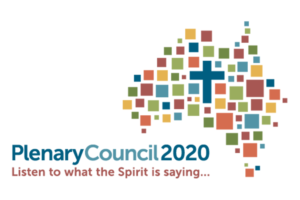 In the lead up to the Plenary Council 2020 Assembly 1 (which has been postponed until October 2021 due to COVID-19), there were two phases of listening.
In the lead up to the Plenary Council 2020 Assembly 1 (which has been postponed until October 2021 due to COVID-19), there were two phases of listening.
To find out more about the Plenary Council 2020, you can visit the:
Additionally, please find below the latest Plenary Council 2020 Media Release.
Media Release: Discernment Papers Help Sharpen Focus for Plenary Council
Archbishop Timothy Costelloe SDB says the six discernment papers for the Fifth Plenary Council of Australia signify the latest milestone as the Church considers its present circumstances and discerns its future.
Six Discernment and Writing Groups, one each for the six national themes for discernment that emerged from the Council’s Listening and Dialogue phase, were tasked with writing papers to bring some major themes and issues into focus…
You’re invited to continue reading the Media Release below:
